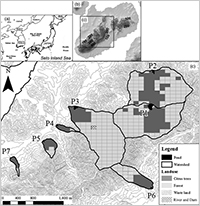Enlarge Image
Longer water retention in ponds increases nitrogen-removal processes
Nutrient removal processes in ponds and the influence of size, shape and other physical characteristics are reported by researchers at Okayama University, Hiroshima University and the National Agriculture and Food Research Organization in Hiroshima in Japan.
Small ponds provide a crucial water supply for farming and agriculture in dry regions, but these activities can give rise to high levels of nitrogen and phosphorus in the water system that cause algal blooms, clogging and putrid conditions. “For sustainable water use in agricultural areas with little rain, greater understanding of the potential of nutrient removal in small ponds and reservoirs is required for effective management and enhancement of removal processes to improve water quality,” explain Mitsuyo Saito and her colleagues in their report.
The researchers studied seven ponds on Ikuchijima, a small island with steep terrain and granite bedrock in the Seto inland sea of Western Japan. Ponds here are important water resources for agriculture. The water volumes of each pond ranged from more than 20,000 m3 to less than 1,300 m3. The researchers monitored water depth – from which they estimated the water volumes – vertical profiles of water temperature, electric conductivity, and chlorophyll-a, as well as in- and outflow channel volumes to estimate the retention time, and nitrogen, phosphorous and silica concentrations.
Retention times were longer in the summer than the winter, which the researchers suggest indicates the use of pond water for irrigation and crop protection. Longer retention times were accompanied by higher rates of nitrogen removal. The researchers also noticed “thermal stratification” in the summer with temperatures lower at deeper levels. An accompanying reduction in chlorophyll-a at deeper levels suggests that the primary production and uptake of nutrients is by phytoplankton, and their levels are affected by thermal stratification.
Trends in phosphorus concentrations differed from those of nitrogen, possibly because phosphorous is easily desorbed from sediments under extreme low oxygen conditions. As a result phosphorous levels could increase for longer residence times.
Publication and Affiliation
M. Saito1*, S. Onodera2, K. Okubo1, S. Takagi3, Y. Maruyama2, G. Jin2 and Y. Shimizu4 Effects of physical and morphometric factors on nutrient removal properties in agricultural ponds. 2015 Water Science and Technology 2187-2193
- Graduate School of Environmental and Life Science, Okayama University, 3-1-1 Tsushima-naka, Kita-ku, Okayama-city, Okayama, 700-8530, Japan
- Graduate School of Integrated Arts and Sciences, Hiroshima University, 1-7-1 Kagamiyama, Higashi-Hiroshima, 739-8521, Japan
- Faculty of Environmental Science and Technology, Okayama University, 3-1-1 Tsushima-naka, Kita-ku, Okayama-city, Okayama, 700-8530, Japan
- National Agriculture and Food Research Organization Western Region Agricultural Research Center Farming Systems and Agro-Environmental-Technologies Research Division, 6-12-1 Nishi-Fukatsu-cho, Fukuyama City, Hiroshima Pref., 721-8514, Japan *corresponding author, e-mail address: misaito@okayama-u.ac.jp

